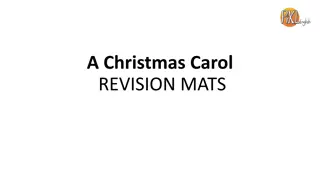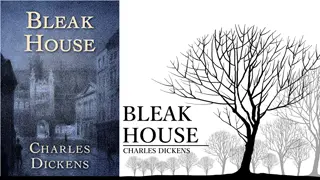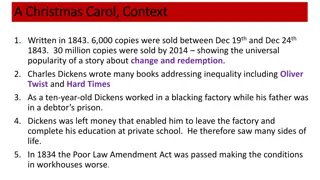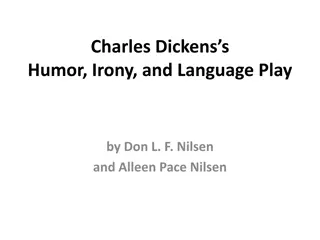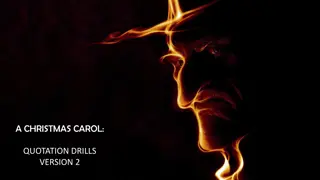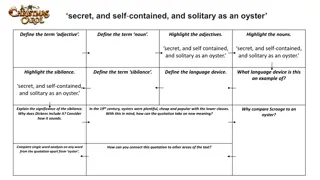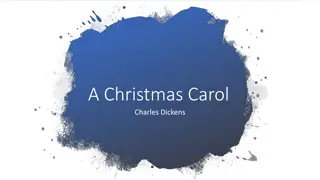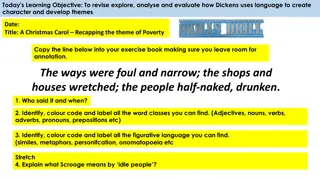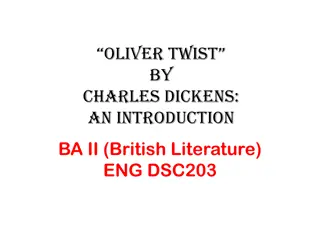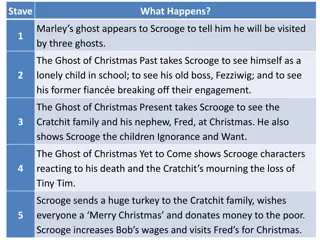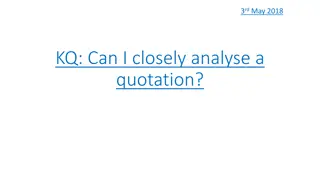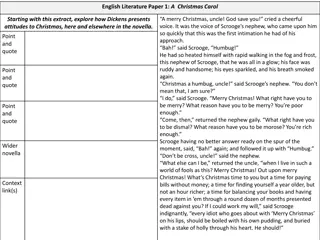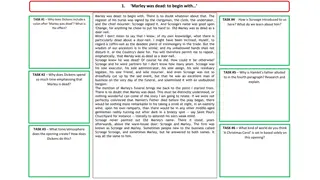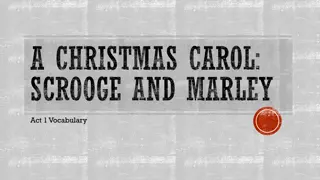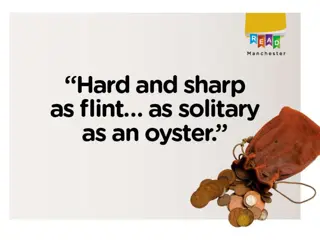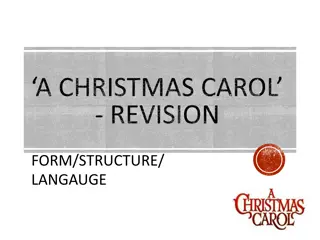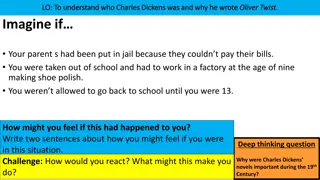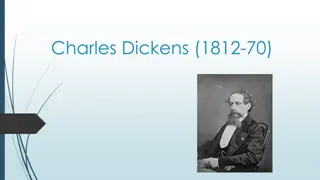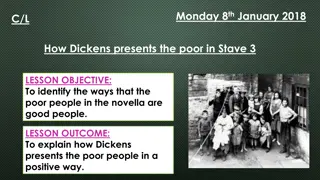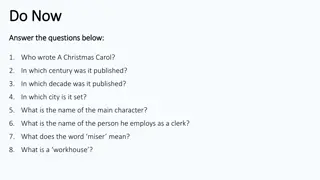Exploring Redemption in A Christmas Carol by Charles Dickens
In "A Christmas Carol," Charles Dickens tells a tale of redemption through the transformation of Ebenezer Scrooge, a miserly businessman, emphasizing the themes of change, charity, and kindness. The story highlights the belief in the possibility of forgiveness and salvation, portrayed through the encounters of Scrooge with the Ghosts of Christmas Past, Present, and Yet to Come. Through Scrooge's journey, readers witness the power of redemption and the capacity for personal change.
Download Presentation

Please find below an Image/Link to download the presentation.
The content on the website is provided AS IS for your information and personal use only. It may not be sold, licensed, or shared on other websites without obtaining consent from the author. Download presentation by click this link. If you encounter any issues during the download, it is possible that the publisher has removed the file from their server.
E N D
Presentation Transcript
A Christmas Carol http://www.sciencebuzz.org/sites/default/files/images/scrooge.preview.jpg http://www.sciencebuzz.org/sites/default/files/images/scrooge.preview.jpg Scrooge s Redemption
Define the words in bold Define the words in bold. Oh! but he was a tight-fisted hand at the grindstone, Scrooge! a squeezing, wrenching, grasping, scraping, clutching, covetous old sinner! Hard and sharp as flint, from which no steel had ever struck out generous fire; secret, and self-contained, and solitary as an oyster. The cold within him froze his old features, nipped his pointed nose, shriveled his cheek, stiffened his gait; made his eyes red, his thin lips blue; and spoke out shrewdly in his grating voice. A frosty rime was on his head, and on his eyebrows, and his wiry chin. He carried his own low temperature always about with him; he iced his office in the dog-days and didn't thaw it one degree at Christmas. Find these language features: List of seven adjectives Metaphor Extended simile Simile Explain the effect of one of these features. Who wrote A Christmas Carol? Who was on the throne at the time it was written? Give the full name of the main character in the story.
Suggested responses: The list of seven adjectives seems excessive. It demonstrates Scrooge s greed and desire for wealth and seems aggressive by using words like wrenching .. The metaphor tight fisted shows that he keeps his money to himself he is selfish.
Look at the images make a list of what happens in Stave 5 of the novella How does Scrooge change from the beginning of the novella? Can you think of any quotes to support your ideas?
A Christmas Carol A Christmas Carol was written by Charles Dickens in the Victorian Era in 1843. It is a Christmas ghost story about the redemption of the miserly businessman, Ebenezer Scrooge. It is an allegorical tale of redemption with the message that everyone is capable of change and the importance of charity and kindness in society.
Redemption the action of being saved or freed from sin or error. It is the belief that no matter how bad a person is in their life, they can still be forgiven and go to heaven, if they truly repent it is an important feature of Christianity. In A Christmas Carol, redemption is the action of being saved from sin, error or evil and avoiding being stuck in purgatory and agony like Jacob Marley. For Jacob Marley, it is too late for redemption, but Marley s Ghost offers Scrooge a chance to avoid the same fate. The Ghost of Christmas Past reminds Scrooge what it is like to feel both joy and sadness. The Ghost of Christmas Present connects him with the feelings and experiences of others. However, it is the Ghost of Christmas Yet to Come that brings about the feelings of true repentance and allows Scrooge the chance to sponge away the writing on this stone .
Cyclical Structure Dickens uses a cyclical structure to show how Scrooge changes and achieves redemption. Scrooge s behaviour and actions are contrasted from the start to the end of the novella. Dickens uses the transformation of Scrooge s character to give hope to all people that they can improve their lives.
Scrooges redemption is the main focus of the text. For Scrooge to achieve redemption, he needs to give up his mean and miserly ways and make up for the bad things he has done. At first it seems impossible that he will change. In Stave One, he is portrayed negatively and his dislike of other people is shown by his attitude to charity It s enough for a man to understand his own business and not to interfere with other people s By the time he is visited by the last ghost, his attitude has changed, but he is worried that he is past all hope . However, he keeps his promise to change for the better and starts to set things right in the final chapter. Dickens is arguing that even the very worst people in society can find redemption as long as they start making changes to their lives.
Dickens is teaching us a moral lesson Dickens is trying to teach his readers a lesson about the importance of charity, love, hope and compassion. Scrooge s journey of redemptions shows us that it is kindness and not money that leads us to happiness. Dickens believed that our actions could improve society.
Recap Explain the lesson that Dickens trying to teach his readers?
Stave 1 Scrooge Ebenezer Scrooge is a miserly character at the start of the novella. He treats his clerk, Bob Cratchit, poorly and is only concerned about making money. On Christmas Eve, in his office, Scrooge has four visitors: Fred his nephew Two charity collectors A Carol singer He is rude to them all. When he returns home, he is visited by the ghost of his former business partner, Jacob Marley. Scrooge is presented as an unpleasant character at the start of the novella. Why do you think that Dickens uses a character like this to explore the theme of redemption?
Recap What day is the novella set on? What is the name of Scrooge s nephew? What is the name of Scrooge s clerk? What is the name of Scrooge s former business partner? Who visits Scrooge in his office on Christmas Eve?
Misanthropic having or showing a dislike of other people (unsociable) Dickens presents Scrooge as a misanthropist whose dislike of other people is shown by his attitude to his visitors on Christmas Eve. Scrooge prefers to be on his own and avoid people as he is characterised as misanthropic.
Choose two correct statements: If you are misanthropic you A. Have a hatred towards other people B. Are lonely C. Enjoy other people s company D. Choose to be unsociable
Description of Scrooge Oh! but he was a tight-fisted hand at the grindstone, Scrooge! a squeezing, wrenching, grasping, scraping, clutching, covetous old sinner! Hard and sharp as flint, from which no steel had ever struck out generous fire; secret, and self-contained, and solitary as an oyster. The cold within him froze his old features, nipped his pointed nose, shriveled his cheek, stiffened his gait; made his eyes red, his thin lips blue; and spoke out shrewdly in his grating voice. A frosty rime was on his head, and on his eyebrows, and his wiry chin. He carried his own low temperature always about with him; he iced his office in the dog-daysand didn't thaw it one degree at Christmas. Grindstone a round solid stone used for sharpening knives and tools Covetous = eagerly or enviously wanting things Flint = a very hard mineral that produces a spark when struck Oyster = a mollusc that lives in a hard shell Gait = way of walking Rime = ice formed by droplets of fog Dog days: the hottest days of the year Which words link to coldness?
Scrooge loves money Scrooge is presented as a misanthropist Fred Two charity collectors A carol singer Bob Cratchit
Hard and sharp as flint had ever struck out generous fire; flint, from which no steel Flint is a rock used to make fire. The adjective hard suggests lack of compassion towards others. The adjective sharp suggests pain implying that Scrooge causes harm to those around him.
secret, and self-contained, and solitary as an oyster oyster. The simile solitary as an oyster highlights Scrooge s hard exterior, which protects him from social interaction The adjectives secret and self-contained show he is unsociable Scrooge is closed to others and has chosen to isolate from society It is rare to find pearls in oysters. They are like a hidden treasure What could the pearl symbolize?
How does this quote present Scrooge as misanthropic? Hard and sharp as flint, from which no steel had ever struck out generous fire; secret, and self-contained, and solitary as an oyster. Why do you think Dickens uses these similes to represent Scrooge at the start of his story?
Salvation being saved from evil or harm Through the character of Scrooge, Dickens shows that even the worst people have a chance of salvation.
Jacob Marley I wear the chains I forged in life Explain this quote using at least two of the following words and phrases: Purgatory Eternal damnation Condemned Suffering
Forbearance = patience and self control Benevolence = kind and helpful to others Penance = self punishment Procuring = persuading Marley s Warning The common welfare was my business; charity, mercy, forbearance, benevolence, were, all, my, business. The dealings of my trade were but a drop of water in the comprehensive ocean of my business! That is no light part of my penance, pursued the ghost. I am here tonight to warn you, that you have yet a chance and hope of escaping my fate. A chance and hope of my procuring, Ebenezer.
Jacob Marley Marley s main role in the novel is to warn Scrooge about what will happen to him if he does not change. Marley and Scrooge have similar personalities. They are obsessed with money and don t care about other people Scrooge lives in Marley s old rooms and even answer to Marley s name, it was all the same to him Marley regrets that he didn t change his ways while he was alive it is too late for him to avoid suffering, he tells Scrooge that he regrets being misanthropic, Business! Cried the Ghost, wringing its hands again. Mankind was my business. Marley tells Scrooge that his presence is a chance and hope of his own procuring This suggests that he has tried (and succeeded) to find a way to help Scrooge and give him a chance to save himself.
Countenance = facial expression Faltering = weakening Shun = to avoid Jacob Marley s Warning You were always a good friend to me, said Scrooge. You will be haunted, resumed the Ghost, by Three Spirits. Scrooge s countenance fell almost as low as the Ghost s had done. Is that the chance and hope you mentioned, Jacob? He demanded in a faltering voice. It is. I I think I d rather not, said Scrooge. Without their visits, said the Ghost, you cannot hope to shun the path I tread. Find a quote to suggest that Scrooge does not welcome salvation
Recap What is the Jacob Marley s function in the story? Why does Scrooge need salvation?
Write a short paragraph explaining Dickens ideas of redemption in the opening of the novella. Explain how Dickens characterises Scrooge as misanthropic Explain the role of Jacob Marley in the journey to redemption. Sentence starts: Words to include: Misanthropic Redemption Salvation At the beginning of the story Dickens presents Scrooge as The idea of redemption is shown by
Why do you think chance and hope are repeated? That is no light part of my penance, pursued the ghost. I am here tonight to warn you, that you have yet a chance and hope of escaping my fate. A chance and hope of my procuring, Ebenezer. You will be haunted, resumed the Ghost, by Three Spirits. Scrooge s countenance fell almost as low as the Ghost s had done. Is that the chance and hope you mentioned, Jacob? He demanded in a faltering voice. It is. I I think I d rather not, said Scrooge. Without their visits, said the Ghost, you cannot hopeto shun the path I tread.


